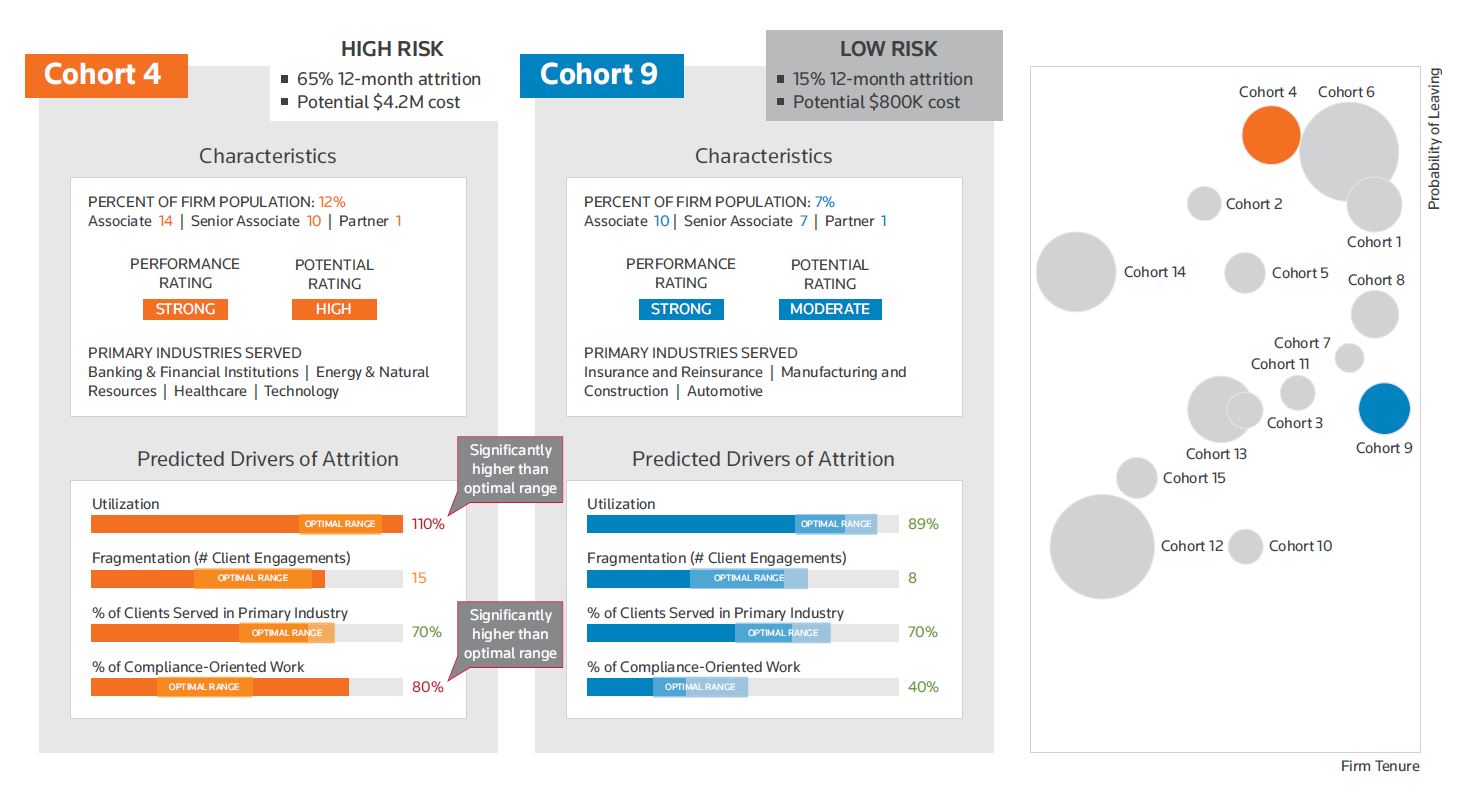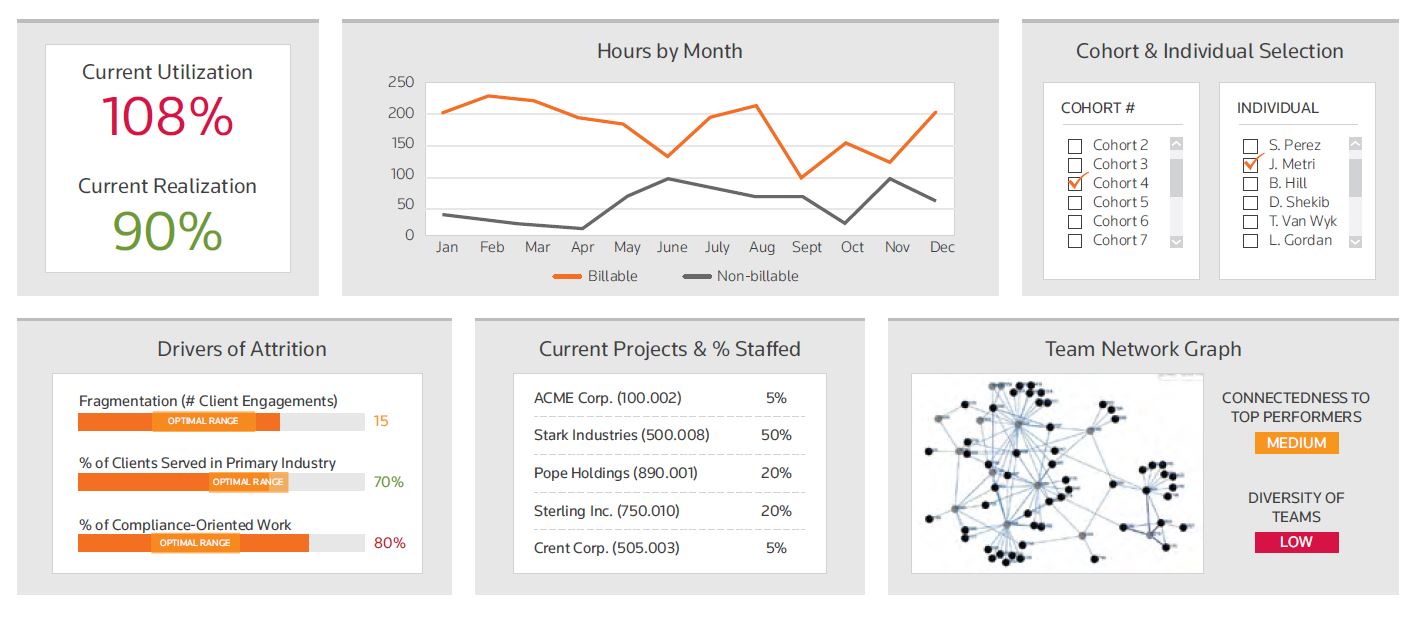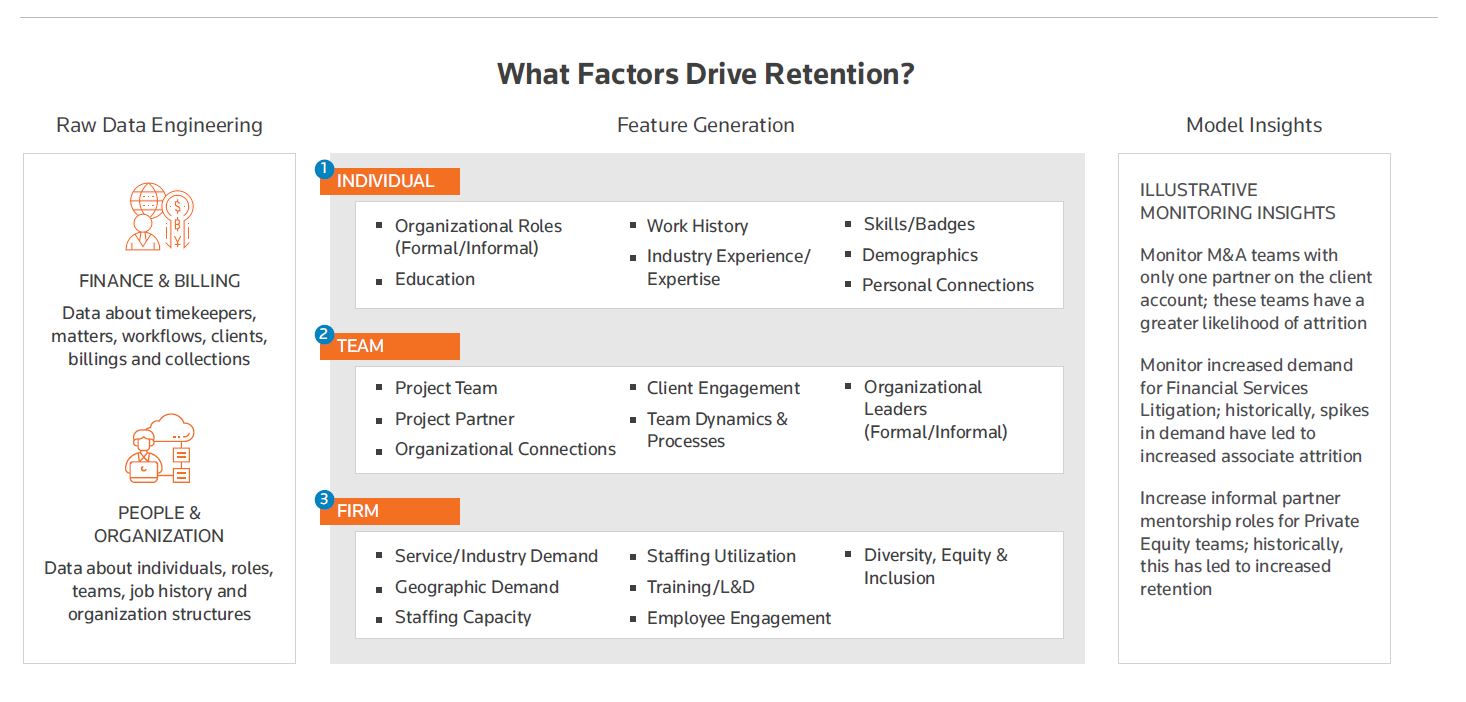Can law firms benefit from creating an “early warning system” for attrition?
Much is being written about the “Great Resignation,” an ongoing economic trend in which employees across many levels, especially those mid-career, are resigning at rates not seen before. The professional services industry had a retention issue even prior to the Great Resignation; and according to the US Bureau of Labor Statistics, professional service firms have the fifth-worst industry retention rate at 63.5%.
Effects of the pandemic have further exacerbated the trend within the industry. For example, the average associate attrition rate in Am Law 100 firms was reported at 16% per year, pre-pandemic. Figures recently reported by Leopard Solutions put that figure at 27% in 2021.
Let’s assume a firm starts with an associate class of 60 new hires. A decade later, only four or five attorneys are likely to remain at the firm. Using $200,000 to $500,000 as an average cost of attrition per associate based on original recruiting costs, training and development investments, replacement costs, etc., a firm could be losing anywhere from $13 million to $28 million per class. Consider those figures across multiple associate classes and the cost of the problem becomes quite sobering.
There is no doubt law firms have enormous difficulty getting (and keeping) enough talent to deliver on client needs. Attrition continues to persist, specifically at the staff and associate levels, resulting in more senior staff and partners working down a level or two just to complete work. This not only risks disengagement of more senior resources operating at levels below their current capabilities, but also will eventually resurface as an air gap in the partner pipeline that will dramatically slow growth. Firm leadership would be remiss to ignore these looming challenges while basking in recent financial successes created by temporary operational savings.
Last year saw many Am Law 100 firms raise salaries above $200,000 for the first time, reflecting record-breaking profits and the desperate efforts to fend off competition for talent.
Most firms have tried to solve the attrition problem by a) funneling a significant portion of their free cash into raising associate and staff salaries, and b) giving larger bonuses as a sweetener for associates at all levels to stay with the firm. Last year saw many Am Law 100 firms raise salaries above $200,000 for the first time, reflecting record-breaking profits and the desperate efforts to fend off competition for talent. Money often surfaces as the reason professionals give for leaving, but more often there is a mix of reasons why people go (or stay).
While talent movement over the last 18 months has been significant, and some professionals are moving out of the industry entirely, most are unlikely to exit permanently. Consider this recent stat from Firm Prospects, an intelligence company that analyzes law firm hiring – Big Law kept 17.71% more of its attorneys in 2021 than in 2019. Instead, lawyers are re-examining the conditions, culture and type of firm they want to be a part of going forward. They’ve harbored these thoughts and desires for a long time, and now they have the leverage to choose – or even reshape – the type of firm that best matches their goals, lifestyle and values.
There are dozens of situations and aspects over time which influence a lawyer’s decision to re-examine or leave a firm, most of which aren’t as easy to see in the moment. Moreover, the set of reasons that keep people at a firm, while putting forth maximum effort, does not always follow traditional age, title, tenure or other segmentations we naturally want to ascribe to them. This is precisely why periodic surveys and exit interviews have limited effectiveness – done as they are at a point-in-time and segmented along traditional lines – they instead spin off expensive initiatives and actions that ultimately don’t yield results. Further, these inquiries often aren’t attached to the sometimes complex and nuanced value proposition to which talent is responding. Nonetheless, a vast majority of firms will stick with this ineffective and costly approach because it seems a visible sign of caring and action, and a better approach is anything but clear.
Firms could truly crack the code by creating an early warning system for attrition. Firm data, already at leadership’s fingertips, contains much of the answer, and data science can connect the dots as to what matters most to which cohorts, even when it isn’t intuitive to consider who is in the cohort.

Consider a few paradoxical personae:
-
-
- A 40-something technology expert who just started a family may actually be elated to work longer hours for current pay if he or she is afforded the ability to work with certain people or on certain types of projects.
- A newly minted partner who is otherwise successful but works with a narrow group, mainly non-diverse teams, and is rarely brought in by other partners on pitches despite industry-leading expertise: This partner is unsurprisingly likely to leave.
- Someone who otherwise has all the reasons in the world to stay, except there have been a few too many matters on which she was staffed below her capability and with colleagues who are not of the same caliber: This situation pushes her out.
-
Each of these individuals belongs to a cohort – one that is not necessarily obvious, with signals that are unclear or noisy without digging into the data. There might be 5, 10 or 15 of these individuals within a firm, but unlikely dozens. So, it is a manageable issue to solve.
Data science, coupled with a deep understanding of law firms and talent development, reveals not only the surprising cohorts that act on the same elements, but also what those elements are, when they happen with the most impact in a career, and how to intervene before someone is inclined to leave. Using standard people data, we can complete a cohort cluster analysis to understand like-groups that care about the same things.

Once we’ve established cohorts, we can set thresholds on critical parameters (hours, team characteristics or dynamics, communication responsiveness, compensation, etc.) and monitor employees within cohorts to identify those at risk.

Having data alone about what causes attrition is not enough. Data must be driven to divulge insights that go beyond intuition and must be driven into the business processes of a firm to have real impact.
Doing so can have significant and immediate impact to the business that could result in gains of millions of dollars (or eliminated losses) per year for a major firm. Isn’t it worth it to find out what your data can tell you?






